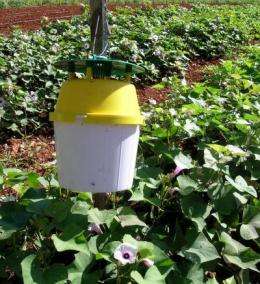Biocontrol of sweetpotato weevils

The warm humid conditions of the tropics make it tough for farmers to keep their crops pest free. For sweetpotato growers in Micronesia, the sweetpotato weevil seems to defy efforts to control its population. Some farmers have been applying toxic pesticides in an effort to control the weevils but they have not been successful. Since the grubs bore inside the tubers, the chemicals do not affect the immature stages. The sweetpotato weevil is a year round pest under warm conditions and even small populations can cause severe damage to the tubers.
University of Guam scientist Dr. Gadi V.P. Reddy has received a $75,000 Conservation Innovation Grant (CIG) from USDA Natural Resources Conservation Service (NRCS) to help growers in the region using an integrated control strategy that will control the weevils and eliminate the use of toxic pesticides.
Dr. Reddy is applying Integrated Pest Management (IPM) techniques to reduce the numbers of weevils in farmer's fields. He has been developing effective trapping methods that utilize scents attractive to weevils (pheromones) and lethal fungi to control weevil populations. Before the weevils can say, "There's a fungus among us," they are infected with a fungus that can seriously disable and eventually kill them. These integrated control tactics are environmentally friendly and target a specific insect, namely the sweetpotato weevil, Cylas formicarius.
This NRCS grant will fund Reddy's research into developing efficient pheromone traps for catching weevils that will contain Petri dishes with fungal spores (Beauveria bassiana and Metarhizium anisopliae). The weevils that visit the traps will be infected with the fungus and in turn infect the weevils in the fields.
"The IPM research conducted by Dr. Reddy and his team at the Western Pacific Tropical Research Center (WPTRC) positively impacts sustainable agriculture in the region and beyond," says Greg Wiecko, WPTRC associate director.
Provided by University of Guam

















